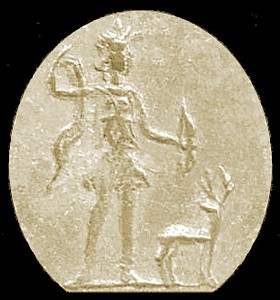  |
Diana
Diana was originally an Italic goddess of light, mountains and woods. Her cult spread throughout Italy and she had a temple at Rome on the Aventine hill since the 6th century BC. Worshipped at Aricia, she was also associated with the moon. Over time Diana was identified with the Greek goddess Artemis whose attributes she acquired: she was regarded as the goddess of the hunt; protectress of women; childbirth and the young. On Roman coins Diana usually appears with a bow, quiver and arrows, and she is often accompanied by a deer or a running hound, and as bringer of light she sometimes holds a torch. Reverse coin types of the first century BC frequently portray Diana holding either a torch; a spear or an arrow, while driving a chariot drawn by deer. As shown left (above) the youthful bust of Diana, the huntress, also distinguished the coins of the gens Postumia. Moneyers of this gens frequently commemorate the victory of the battle at Lake Regillus when their ancestor Albus Postumius (dictator 498 BC) was consul. During the Empire Augustus increasingly emphasised the importance of Diana as the twin sister of Apollo and her image became a very popular reverse type. |